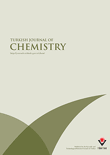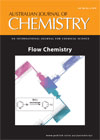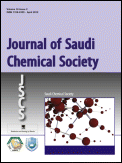
Journal of the Korean Chemical Society-Daehan Hwahak Hoe Jee
Scope & Guideline
Empowering Chemists to Shape the Future
Introduction
Aims and Scopes
- Chemical Synthesis and Characterization:
The journal emphasizes research focused on the synthesis of new chemical compounds and materials, including nanomaterials, polymers, and organic compounds, and their characterization using advanced techniques. - Analytical Chemistry:
There is a strong focus on the development and application of analytical methods for the detection and quantification of chemical species, including environmental pollutants and biological markers. - Education and Pedagogical Research:
The journal explores innovative teaching methodologies in chemistry education, examining the effectiveness of various pedagogical approaches and their impact on student learning outcomes. - Environmental Chemistry:
Research related to the environmental impact of chemicals, including studies on pollution, remediation techniques, and sustainable practices is a core area of interest. - Computational Chemistry and Theoretical Studies:
The journal publishes studies that employ computational methods to explore chemical phenomena, including molecular modeling, density functional theory, and simulations. - Biochemistry and Pharmacology:
Research that intersects chemistry and biology, including studies on the mechanisms of drug action, synthesis of bioactive compounds, and their therapeutic potentials, is also highlighted.
Trending and Emerging
- Green Chemistry and Sustainability:
There is a notable increase in research focused on sustainable practices, including the development of eco-friendly materials and methodologies that minimize environmental impact. - Nanotechnology and Materials Science:
The journal has seen a rise in studies related to nanomaterials, their synthesis, characterization, and applications in various fields, including electronics and medicine. - Artificial Intelligence and Machine Learning in Chemistry:
Emerging research utilizing AI and machine learning techniques to enhance chemical analysis, predict reactions, and improve educational methodologies has gained traction. - Health-related Chemical Research:
There is an increasing emphasis on studies investigating the chemical basis of diseases, drug development, and therapeutic applications, reflecting a growing intersection between chemistry and health sciences. - Interdisciplinary Education Approaches:
Research that combines chemistry education with technology and innovative teaching strategies is trending, indicating a shift towards more integrated and effective educational practices.
Declining or Waning
- Traditional Organic Synthesis:
There appears to be a waning interest in conventional organic synthesis methods that do not incorporate modern techniques or applications, as the journal pivots towards more innovative and interdisciplinary approaches. - Basic Inorganic Chemistry:
Research focusing solely on fundamental aspects of inorganic chemistry without practical applications or interdisciplinary connections has become less prominent in recent issues. - Historical Chemistry Studies:
Papers exploring historical perspectives of chemistry or retrospective analyses of chemical theories have decreased, as the focus shifts to contemporary challenges and innovations in the field. - Single-Disciplinary Studies:
Research that does not integrate concepts from other disciplines, such as biology or materials science, is becoming less common, reflecting a trend towards more interdisciplinary research.
Similar Journals

Journal of Chemistry and Technologies
Connecting Ideas, Transforming Technologies.The Journal of Chemistry and Technologies, published by OLES HONCHAR DNIPROPETROVSK NATIONAL UNIVERSITY, is an open access journal dedicated to advancing knowledge in the broad fields of chemistry and chemical engineering since its inception in 2013. With ISSN 2663-2934 and E-ISSN 2663-2942, this journal provides a vital platform for researchers and professionals, particularly in Ukraine and beyond, to share innovative research findings and contemporary technological advancements. Currently ranked in the Q4 quartile in both Chemical Engineering and General Chemistry for 2023, it serves as an enriching resource for those interested in emerging trends and interdisciplinary studies within these domains. The journal adheres to high academic standards while fostering collaboration in the scientific community by offering open access articles that ensure visibility and accessibility to a global audience. As an important part of the academic landscape, the Journal of Chemistry and Technologies aims to inspire future research and development, paving the way for new discoveries and applications in chemistry-related fields.

Ovidius University Annals of Chemistry
Connecting Researchers, Inspiring Discoveries.Ovidius University Annals of Chemistry is a prominent open-access journal dedicated to the field of chemistry and chemical engineering, published by OVIDIUS UNIV PRESS since 2012. With its ISSN 1583-2430 and E-ISSN 2286-038X, this journal seeks to foster innovative research and disseminate knowledge across diverse chemical disciplines. Situated in the vibrant academic setting of Ovidius University in Constanta, Romania, this journal receives contributions from a global pool of researchers, enhancing its relevance in the international scientific community. The open-access format ensures that all published articles are freely available, promoting a wider reach and impact of the research dissemination. As a valued resource for academics, industry professionals, and students alike, the Ovidius University Annals of Chemistry plays a crucial role in advancing the understanding of chemical sciences and engineering practices.

Journal of the Mexican Chemical Society
Illuminating the Path of Chemical DiscoveryWelcome to the Journal of the Mexican Chemical Society, an essential publication for researchers and professionals in the field of chemistry. Published by the reputable SOC QUIMICA MEXICO, this journal has been a vital platform for sharing innovative research and developments in the field since its inception in 2008. With an ISSN of 1870-249X and an E-ISSN of 1665-9686, the journal provides valuable insights and contributes to the global scientific community. As of 2023, it holds a Q3 quartile ranking in miscellaneous chemistry categories and ranks #258 out of 408 in General Chemistry on Scopus, placing it at the 36th percentile among its peers. Although currently not an open access journal, it remains committed to disseminating high-quality research that supports advancements in chemical education, practice, and technology. Researchers, academics, and students are encouraged to engage with this journal to explore groundbreaking studies and enhance their understanding of diverse chemical disciplines.

Canadian Journal of Chemistry
Advancing Chemistry Through Innovative ResearchWelcome to the Canadian Journal of Chemistry, a prominent publication dedicated to advancing the study of chemistry through original research and critical reviews. Published by Canadian Science Publishing, this journal has been a cornerstone of chemical research since its inception, covering a broad spectrum of topics within the field, including catalysis, organic chemistry, and general chemistry. With an ISSN of 0008-4042 and E-ISSN of 1480-3291, it provides a vital platform for researchers, professionals, and students to disseminate their findings and engage in scholarly discourse. Impact Factor is currently in development, with the journal classified in the Q4 category for catalysis and Q3 for miscellaneous chemistry fields, signifying its evolving contributions to the scientific community. The journal operates without an open access model, which ensures a rigorous peer-review process while maintaining subscription access for institutions and libraries. Located in Ottawa, Canada, the Canadian Journal of Chemistry continues to provide an invaluable resource for those dedicated to the scientific pursuit of chemistry, making significant strides in fostering interdisciplinary approaches and innovative research methodologies.

TURKISH JOURNAL OF CHEMISTRY
Bridging Theory and Application in ChemistryTURKISH JOURNAL OF CHEMISTRY, published by the Tubitak Scientific & Technological Research Council Turkey, serves as a significant platform for the dissemination of research in the diverse field of chemistry. Since its inception in 1996, this peer-reviewed journal has made substantial contributions to the body of knowledge within the field, currently holding a respectable Q3 ranking in the category of Chemistry (miscellaneous) as of 2023. Researchers and professionals alike rely on this journal for its wide-ranging discussions, innovative methodologies, and noteworthy findings pertinent to both fundamental and applied chemistry. With an ISSN of 1300-0527 and a commitment to promoting scientific progress, the journal is accessible to a global audience and encourages the open sharing of insights that drive advancements in chemistry. The extended timeframe of convergence until 2024 highlights the journal's dedication to fostering ongoing research and collaboration within the scientific community. As a valuable resource for researchers, professionals, and students, the Turkish Journal of Chemistry aims to inspire new discoveries and facilitate knowledge transfer in a dynamic and evolving discipline.

JOURNAL OF THE INDIAN CHEMICAL SOCIETY
Showcasing the Evolution of Chemical Sciences since 1973Journal of the Indian Chemical Society, published by Elsevier, stands as a cornerstone in the field of chemistry, particularly representing the rich chemical research emanating from India.
With a significant history dating back to its establishment, this journal encompasses diverse disciplines including Drug Discovery, Electrochemistry, Inorganic Chemistry, Organic Chemistry, and Physical and Theoretical Chemistry, reflecting the evolving landscape of chemical sciences.
Despite being positioned in the Q3 category across multiple quarters, the journal demonstrates promising rankings in various chemistries, highlighting its commitment to advancing the knowledge and application of chemical sciences. While currently not available as an open access journal, the Journal of the Indian Chemical Society is dedicated to providing a platform for high-quality research that fosters innovation and collaboration among researchers, professionals, and students worldwide.
With its continuous publication from 1973 to the present, it serves as an essential repository for cutting-edge findings and developments in chemistry, striving to connect academia with industry and practice.

Izvestiya Vysshikh Uchebnykh Zavedenii Khimiya i Khimicheskaya Tekhnologiya
Connecting Scholars in the World of ChemistryIzvestiya Vysshikh Uchebnykh Zavedenii Khimiya i Khimicheskaya Tekhnologiya is a prominent academic journal dedicated to the fields of chemistry and chemical technology, published by the esteemed IVANOVSKOGO KHIMIKO-TEKHNOLOGI TSHESKOGO INST in the Russian Federation. With an ISSN of 0579-2991 and E-ISSN of 2500-3070, this journal has been a crucial platform since its inception in 1980, showcasing significant advancements and research findings, particularly in its converged periods from 1980, 1982, and 2017 to 2024. The journal is ranked Q3 in Chemical Engineering and Chemistry, reflecting its dedication to quality scholarship. Although open access options are currently unavailable, the journal plays a vital role in disseminating knowledge and fostering collaboration among researchers, professionals, and students in these critical scientific domains. Situated in Ivanovo, Russia, it continues to be a focal point for impactful research, making it an essential resource for those aiming to stay at the forefront of innovation in chemistry and chemical engineering.

AUSTRALIAN JOURNAL OF CHEMISTRY
Fostering global collaboration in chemical sciences.The Australian Journal of Chemistry, with an ISSN of 0004-9425 and an E-ISSN of 1445-0038, is a distinguished publication from CSIRO PUBLISHING, dedicated to advancing the field of chemistry since its inception in 1948. Based in Australia, this journal serves as a platform for original research articles, reviews, and innovative studies that encompass a wide spectrum of chemical disciplines, aiming to foster communication and collaboration among researchers globally. Despite its Q3 ranking in the Chemistry (Miscellaneous) category and standing at rank #236 in Scopus’ general chemistry classification, it remains an essential resource for professionals and students seeking to stay informed about emerging trends and discoveries in chemistry. The journal does not offer open access, emphasizing the premium quality of peer-reviewed content that adheres to rigorous academic standards. By bridging theory and practice, the Australian Journal of Chemistry continues to play a crucial role in shaping the future of chemical sciences.

Orbital-The Electronic Journal of Chemistry
Illuminating the Path of Chemical DiscoveryOrbital - The Electronic Journal of Chemistry, ISSN 1984-6428, is an esteemed open-access journal published by the Universidade Federal de Mato Grosso do Sul, Department of Chemistry, since 2009. Located in the vibrant academic landscape of Campo Grande, Brazil, this journal aims to bridge the gap between research and practice in the fields of Chemistry, Chemical Engineering, and Materials Science. Despite its current categorization in the Q4 quartile ranks, Orbital plays a pivotal role by providing a platform for innovative ideas, emerging technologies, and interdisciplinary research that advances the understanding of chemical processes and materials. With its commitment to open access, the journal ensures that research findings are readily available to a global audience, promoting collaboration and knowledge dissemination among researchers, professionals, and students alike. Readers can expect a diverse range of articles, from foundational chemistry studies to cutting-edge developments in materials science, reflecting the journal’s dynamic scope and contribution to the scientific community.

Journal of Saudi Chemical Society
Fostering Global Collaboration in Chemical Research.The Journal of Saudi Chemical Society, published by ELSEVIER, stands as a premier platform for advancing knowledge in the field of chemistry. Since its inception in 2009, this Open Access journal has garnered significant attention, securing a prestigious Q1 ranking in the Chemistry (miscellaneous) category for 2023, reflecting its position among the top journals in the discipline. With an impressive Scopus ranking of #66 out of 408 in General Chemistry, this journal boasts a commendable 83rd percentile, underscoring its impact and relevance in the global research community. The journal aims to disseminate high-quality research articles, reviews, and case studies, fostering innovation and collaboration among chemists and allied professionals. By enabling widespread access to cutting-edge research, the Journal of Saudi Chemical Society plays a crucial role in supporting the educational and professional development of students, researchers, and practitioners alike, making it an essential resource for anyone invested in the dynamic field of chemistry.